On this day 150 years ago my second great-granduncle, Eleazer Wilber, a private in the 27th Massachusetts Infantry Regiment, was captured along with most of his regiment at the Battle of Drewry's Bluff. General Benjamin Butler, commander of the Army of the James, one of the three wings of the Union Army under the command of Major General Ulysses S. Grant, was ordered to drive toward Richmond from the east as General Grant drove the Army of the Potomac from the north. On the early morning of May 16, 1864, much of the 27th Massachusetts Infantry Regiment was captured by Confederate forces led by General Pierre G.T. Beauregard during an early morning reconnaissance in heavy fog. Two hundred thirty five men of the 27th Massachusetts Infantry Regiment, including Eleazer, were taken prisoner and sent to the dreaded Andersonville Prison in Georgia.1
References:
1Compiled service record, Eleazer Wilber, Pvt., Co. G, 27th Massachusetts Infantry; Carded Records, Volunteer Organizations, Civil War; Records of the Adjutant General's Office, 1780s-1917, Record Group 94; National Archives, Washington, D.C.
Friday, May 16, 2014
Battle of the Wilderness Walking Tour at Mount Auburn Cemetery
On Saturday I attended a Civil War themed walking tour at Mount Auburn Cemetery in Cambridge to commemorate the sesquicentennial anniversary of the Battle of the Wilderness, a two-day conflagration which took place on May 5-6, 1864, in the woods and farmlands of Spotsylvania County, Virginia. The Battle of the Wilderness was the inaugural conflict of Union General Ulysses S. Grant's Overland Campaign, a series of brutal battles in Virginia with the objective to capture the Confederate capital at Richmond. We began our tour with an introductory presentation on the battle at Story Chapel and then began our visits to the gravesites of officers, enlisted, and civilians who took part in this fateful battle.
Lieutenant Colonel Waldo Merriam of the 16th Massachusetts Infantry Regiment fought at the Battle of the Wilderness and was subsequently killed at the Battle of Spotsylvania on May 12, 1864. He was a member of the Massachusetts First Corps of Cadets, a military organization dating from 1741 which provided officers and recruits for Massachusetts regiments.
 1
1
Henry May Bond was an adjutant with the 20th Massachusetts Infantry Regiment. He was wounded in the jaw on May 6 at the Battle of the Wilderness and was subsequently transported in an ambulance to a hospital with other wounded officers of his regiment. On the route Henry's ambulance was intercepted by Confederate Colonel John Singleton Mosby's Raiders. Henry was tragically and fatally wounded in the encounter.
 2
2
Famed artist Winslow Homer was an artist correspondent for Harper's Weekly magazine during the Civil War years. His sketches and drawings brought a visual representation of the war to civilians and families on the home front.
.jpg)
 3
3
Henry Larcom Abbot was an army engineer and brigadier general with the Union Army. He engineered and led the siege artillery brigade at Petersburg and Richmond.
 4
4
John Michael Tobin of the 9th Massachusetts Infantry Regiment won the Medal of Honor for his exemplary service at the Battle of Malvern Hill on July 1, 1862. Tobin took voluntary command of the 9th Massachusetts Infantry after the wounding of regimental commander Colonel Thomas Cass, rallying and reforming the regiment and twice picking up the regimental colors during a series of attacks.
 5
5
Joseph S. Hills was a captain in the 16th Massachusetts Infantry Regiment who was killed at the Battle of the Wilderness on May 6, 1864. He fell while leading and encouraging his men forward during the fight. His gravestone memorial prominently displays a hat and sword to commemorate his Civil War service, along with inscriptions for fidelity and bravery under fire.
.jpg)
 6
6
Charles Folsom served as quartermaster in the 20th Massachusetts Infantry Regiment during the Civil War and was subsequently a superintendent of Mount Auburn Cemetery.
.jpg)
.jpg) 7
7
Charles Devens was a brigadier general in the 15th Massachusetts Regiment Infantry. His unit was the first to occupy Richmond in 1865.
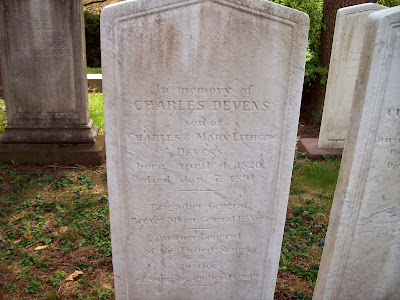.jpg) 8
8
Zabdiel Boylston Adams was a surgeon with the 36th Massachusetts Regiment. He pioneered techniques for treatment of wounded soldiers on the battlefield. He was captured by Confederate forces at the Battle of the Wilderness and treated his own wounds by pouring pure nitric acid directly into his gangrenous leg.
 9
9
Lieutenant Colonel Theodore Lyman was an archivist and an aide-de-camp to General George Meade, commander of the Army of the Potomac, at the Battle of the Wilderness. Lyman documented his Civil War service in a compilation of letters and diaries.
 10
10
Henry Todd, a colorbearer for the 36th Massachusetts Infantry Regiment, was killed waving his unit's colors at the Battle of the Wilderness on May 6, 1864. His gravestone commemorates his service as colorbearer for his regiment.
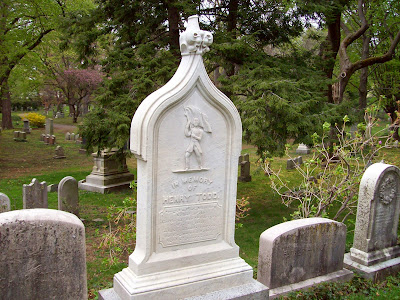 11
11
Charles Carleton Coffin was a journalist and Civil War correspondent. He accompanied the Army of the Potomac for the entire duration of the war and was an eyewitness to major battles.
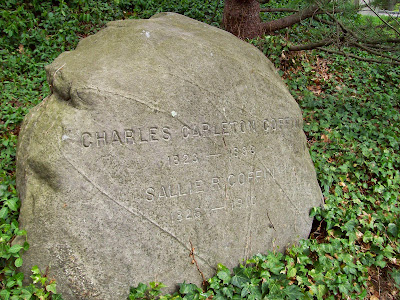.jpg) 12
12
Mount Auburn docents Bill McEvoy and Rosemarie Smurzynski were our wonderful guides for this moving and informative tour. For additional information about Civil War walks at Mount Auburn please visit http://mountauburn.org/tag/civil-war/. For other events at Mount Auburn please visit their calendar of events at http://www.mountauburn.org/category/events. For additional information about previous Civil War walks at Mount Auburn Cemetery please visit my blog posts labeled Mount Auburn Cemetery and Civil War Walking Tours.
References:
1Mount Auburn Cemetery (Cambridge, Middlesex County, Massachusetts), Waldo Merriam marker, Fountain Avenue, Lot 2922, photographed by Carol Swaine-Kuzel, 10 May 2014.
2Mount Auburn Cemetery, Bond family marker, Indian Ridge Path, Lot 156, photographed by Carol Swaine-Kuzel, 10 May 2014.
3Mount Auburn Cemetery, Winslow Homer marker, Lily Path, Lot 563, photographed by Carol Swaine-Kuzel, 10 May 2014.
4Mount Auburn Cemetery, Henry Larcom Abbot marker, Fuchsia Path, Lot 3705, photographed by Carol Swaine-Kuzel, 10 May 2014.
5Mount Auburn Cemetery, John Michael Tobin,Chestnut Avenue, Lot 1049, photographed by Carol Swaine-Kuzel, 10 May 2014.
6Mount Auburn Cemetery, Joseph S. Hills marker, Petunia Path, Lot 1450, photographed by Carol Swaine-Kuzel, 10 May 2014.
7Mount Auburn Cemetery, Charles Folsom marker, Myrtle Path, Lot 33, photographed by Carol Swaine-Kuzel, 10 May 2014.
8Mount Auburn Cemetery, Charles Devens marker, Tulip Path, Lot 1594, photographed by Carol Swaine-Kuzel, 10 May 2014.
9"Lecture, Mitchell Adams, Dr. Zabdiel Boylston Adams: Surgeon and Soldier for the Union," Lecture, Mitchell Adams, Dr. Zabdiel Boylston Adams: Surgeon and Soldier for the Union (http://www.bostonathenaeum.org/events/1739/lecture-mitchell-adams-dr-zabdiel-boylston-adams-surgeon-and-solider-union: 16 May 2014). Mount Auburn Cemetery, Zabdiel Boylston Adams marker, Elder Path, Lot 2700, photographed by Carol Swaine-Kuzel, 10 May 2014.
10Mount Auburn Cemetery, Theodore Lyman marker, Pilgrim Path, Lot 705, photographed by Carol Swaine-Kuzel, 10 May 2014.
11Mount Auburn Cemetery, Henry Todd marker, Spruce Avenue, Lot 1762,photographed by Carol Swaine-Kuzel, 10 May 2014.
12Mount Auburn Cemetery, Charles Carleton Coffin marker, Gentian Path, Lot 5981, photographed by Carol Swaine-Kuzel, 10 May 2014.
Lieutenant Colonel Waldo Merriam of the 16th Massachusetts Infantry Regiment fought at the Battle of the Wilderness and was subsequently killed at the Battle of Spotsylvania on May 12, 1864. He was a member of the Massachusetts First Corps of Cadets, a military organization dating from 1741 which provided officers and recruits for Massachusetts regiments.
 1
1Henry May Bond was an adjutant with the 20th Massachusetts Infantry Regiment. He was wounded in the jaw on May 6 at the Battle of the Wilderness and was subsequently transported in an ambulance to a hospital with other wounded officers of his regiment. On the route Henry's ambulance was intercepted by Confederate Colonel John Singleton Mosby's Raiders. Henry was tragically and fatally wounded in the encounter.
 2
2Famed artist Winslow Homer was an artist correspondent for Harper's Weekly magazine during the Civil War years. His sketches and drawings brought a visual representation of the war to civilians and families on the home front.
.jpg)
 3
3Henry Larcom Abbot was an army engineer and brigadier general with the Union Army. He engineered and led the siege artillery brigade at Petersburg and Richmond.
 4
4John Michael Tobin of the 9th Massachusetts Infantry Regiment won the Medal of Honor for his exemplary service at the Battle of Malvern Hill on July 1, 1862. Tobin took voluntary command of the 9th Massachusetts Infantry after the wounding of regimental commander Colonel Thomas Cass, rallying and reforming the regiment and twice picking up the regimental colors during a series of attacks.
 5
5Joseph S. Hills was a captain in the 16th Massachusetts Infantry Regiment who was killed at the Battle of the Wilderness on May 6, 1864. He fell while leading and encouraging his men forward during the fight. His gravestone memorial prominently displays a hat and sword to commemorate his Civil War service, along with inscriptions for fidelity and bravery under fire.
.jpg)
 6
6Charles Folsom served as quartermaster in the 20th Massachusetts Infantry Regiment during the Civil War and was subsequently a superintendent of Mount Auburn Cemetery.
.jpg)
.jpg) 7
7Charles Devens was a brigadier general in the 15th Massachusetts Regiment Infantry. His unit was the first to occupy Richmond in 1865.
.jpg) 8
8Zabdiel Boylston Adams was a surgeon with the 36th Massachusetts Regiment. He pioneered techniques for treatment of wounded soldiers on the battlefield. He was captured by Confederate forces at the Battle of the Wilderness and treated his own wounds by pouring pure nitric acid directly into his gangrenous leg.
 9
9Lieutenant Colonel Theodore Lyman was an archivist and an aide-de-camp to General George Meade, commander of the Army of the Potomac, at the Battle of the Wilderness. Lyman documented his Civil War service in a compilation of letters and diaries.
 10
10Henry Todd, a colorbearer for the 36th Massachusetts Infantry Regiment, was killed waving his unit's colors at the Battle of the Wilderness on May 6, 1864. His gravestone commemorates his service as colorbearer for his regiment.
 11
11Charles Carleton Coffin was a journalist and Civil War correspondent. He accompanied the Army of the Potomac for the entire duration of the war and was an eyewitness to major battles.
.jpg) 12
12Mount Auburn docents Bill McEvoy and Rosemarie Smurzynski were our wonderful guides for this moving and informative tour. For additional information about Civil War walks at Mount Auburn please visit http://mountauburn.org/tag/civil-war/. For other events at Mount Auburn please visit their calendar of events at http://www.mountauburn.org/category/events. For additional information about previous Civil War walks at Mount Auburn Cemetery please visit my blog posts labeled Mount Auburn Cemetery and Civil War Walking Tours.
References:
1Mount Auburn Cemetery (Cambridge, Middlesex County, Massachusetts), Waldo Merriam marker, Fountain Avenue, Lot 2922, photographed by Carol Swaine-Kuzel, 10 May 2014.
2Mount Auburn Cemetery, Bond family marker, Indian Ridge Path, Lot 156, photographed by Carol Swaine-Kuzel, 10 May 2014.
3Mount Auburn Cemetery, Winslow Homer marker, Lily Path, Lot 563, photographed by Carol Swaine-Kuzel, 10 May 2014.
4Mount Auburn Cemetery, Henry Larcom Abbot marker, Fuchsia Path, Lot 3705, photographed by Carol Swaine-Kuzel, 10 May 2014.
5Mount Auburn Cemetery, John Michael Tobin,Chestnut Avenue, Lot 1049, photographed by Carol Swaine-Kuzel, 10 May 2014.
6Mount Auburn Cemetery, Joseph S. Hills marker, Petunia Path, Lot 1450, photographed by Carol Swaine-Kuzel, 10 May 2014.
7Mount Auburn Cemetery, Charles Folsom marker, Myrtle Path, Lot 33, photographed by Carol Swaine-Kuzel, 10 May 2014.
8Mount Auburn Cemetery, Charles Devens marker, Tulip Path, Lot 1594, photographed by Carol Swaine-Kuzel, 10 May 2014.
9"Lecture, Mitchell Adams, Dr. Zabdiel Boylston Adams: Surgeon and Soldier for the Union," Lecture, Mitchell Adams, Dr. Zabdiel Boylston Adams: Surgeon and Soldier for the Union (http://www.bostonathenaeum.org/events/1739/lecture-mitchell-adams-dr-zabdiel-boylston-adams-surgeon-and-solider-union: 16 May 2014). Mount Auburn Cemetery, Zabdiel Boylston Adams marker, Elder Path, Lot 2700, photographed by Carol Swaine-Kuzel, 10 May 2014.
10Mount Auburn Cemetery, Theodore Lyman marker, Pilgrim Path, Lot 705, photographed by Carol Swaine-Kuzel, 10 May 2014.
11Mount Auburn Cemetery, Henry Todd marker, Spruce Avenue, Lot 1762,photographed by Carol Swaine-Kuzel, 10 May 2014.
12Mount Auburn Cemetery, Charles Carleton Coffin marker, Gentian Path, Lot 5981, photographed by Carol Swaine-Kuzel, 10 May 2014.
Monday, May 12, 2014
Remembering the Battle of Spotsylvania - 150 Years Later
This week marks the sesquicentennial anniversary of the Battle of Spotsylvania, a brutal eleven-day campaign that concluded in a virtual stalemate. Following the Battle of the Wilderness Union General Ulysses S. Grant, unlike his predecessors, chose to pursue Confederate General Robert E. Lee toward Richmond in an attempt to position himself between Lee and the Confederate capital of Richmond, cutting him off from his supply line. However, General Lee had the advantage of a smaller army that knew the terrain, and was able to obtain the military advantage of geographical position before Grant. On May 12 the brutality of this conflict manifested in a pastoral location known to history as "The Bloody Angle," where Union and Confederate forces engaged all-day in severe fighting that produced heavy casualties for both sides.

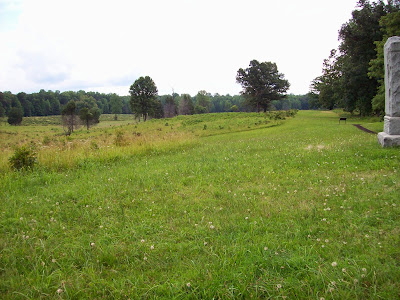

My second great-granduncle Oliver Bates served with the 20th Massachusetts Infantry Regiment at Spotsylvania with General Winfield S. Hancock's Second Corps and was wounded at the Bloody Angle conflict on May 12. Apparently his injuries were not severe, as he continued to fight in the subsequent battles of the Overland Campaign in May and June 1864. On May 18 General Grant departed south again, hoping once more to beat General Lee in the race to Richmond. 1
For additional information about Oliver Bates and the 20th Massachusetts Infantry Regiment please visit http://20thmassregt150.blogspot.com.
References:
1Compiled service record, Oliver S. Bates, Pvt., Co. A, 20th Massachusetts Infantry; Carded Records, Volunteer Organizations, Civil War; Records of the Adjutant General's Office, 1780s-1917, Record Group 94; National Archives, Washington, D.C.



My second great-granduncle Oliver Bates served with the 20th Massachusetts Infantry Regiment at Spotsylvania with General Winfield S. Hancock's Second Corps and was wounded at the Bloody Angle conflict on May 12. Apparently his injuries were not severe, as he continued to fight in the subsequent battles of the Overland Campaign in May and June 1864. On May 18 General Grant departed south again, hoping once more to beat General Lee in the race to Richmond. 1
For additional information about Oliver Bates and the 20th Massachusetts Infantry Regiment please visit http://20thmassregt150.blogspot.com.
References:
1Compiled service record, Oliver S. Bates, Pvt., Co. A, 20th Massachusetts Infantry; Carded Records, Volunteer Organizations, Civil War; Records of the Adjutant General's Office, 1780s-1917, Record Group 94; National Archives, Washington, D.C.
Friday, May 9, 2014
Brattle Street "Tory Row" Walking Tour
Last Saturday I attended a "Tory Row" walking tour along Brattle Street in Cambridge hosted by the Cambridge Center for Adult Education and led by Boston historian Charles Bahne, author of The Complete Guide to Boston's Freedom Trail. The tour focused on mansion homes along Brattle Street that were owned by wealthy Cambridge Loyalists, also known as "Tories," citizens who were loyal to the British Crown at the outbreak of the American Revolution.
The tour began at the William Brattle House at 42 Brattle Street, which is now the main facility of the Cambridge Center for Adult Education. General Major William Brattle Jr. was a decorated military hero of the French and Indian War. Although he appeared to sympathize with the patriots he was a Loyalist, siding with the British Crown in the tensions leading up to the American Revolution. In August of 1774 Brattle wrote a letter to Thomas Gage, the Royal Governor of Massachusetts, informing him of the formation of local militias and the storing of gunpowder in local arsenals. Three days later Gage ordered three hundred soldiers to sail up the Mystic River to Charlestown to seize the gunpowder. The "Powder Alarm" enraged the citizens of Cambridge, who formed a rally of four thousand attendees on the Cambridge Common the next day to protest Gage's actions and to demand the resignation of three Loyalist members of the Mandamus Council appointed by the British Crown. One of the members, Lieutenant Governor Thomas Oliver, rode to Boston to prevent Governor Gage from sending soldiers in an attempt to suppress the crowd. Oliver returned to Cambridge, assuring the crowd that Gage would not employ military action in order to persuade the crowd to disperse peacefully. However, a hated tax collector, Benjamin Hallowell, rode past the crowd in his carriage, and a group of enraged citizens pursued his carriage. After these episodes William Brattle, as well other Cambridge Loyalists, left their Cambridge homes for safer lodgings in Boston. The Loyalists remained in Boston during the Siege of Boston in 1775-1776 and departed from Boston with the British soldiers on Evacuation Day, March 17, 1776.1
.jpg)
The Henry Vassall House at 94 Brattle Street is named for its original owner, Henry Vassall, a wealthy Loyalist landowner and heir to his father's Jamaican plantation and trading interests. Henry Vassall died in 1769. His wife Penelope Royall Vassall vacated the home in 1775 with other Cambridge Loyalists. This home served as the medical headquarters of the Continental Army. Dr. Benjamin Church, a renowned Boston physician, was named by the Continental Congress as the Surgeon General of the Continental Army. Church was later revealed as a traitor to the Revolutionary cause and was held prisoner in this house until his exile from the American Colonies in 1778. 2


The Longfellow House-Washington Headquarters National Historical Site at 105 Brattle Street was built by John Vassall Jr., a Loyalist nephew of Henry Vassall. John Vassall Jr. married Elizabeth Oliver, the sister of Lieutenant Governor Thomas Oliver. The Vassall Family fled the house in 1774 after the "Powder Alarm" rally on Cambridge Common and the ensuing harsh treatment of Governor Oliver. General George Washington established his headquarters here during the Siege of Boston. Fireside poet Henry Wadsworth Longfellow lived in this house from 1843 until his death in 1862. At Longfellow's 1843 marriage to Fanny Appleton her father, Nathan Appleton, gave the newly-married couple this house as a wedding gift. Longfellow's descendants lived in this home until 1950.3:




The Lechmere-Sewall-Riedesel House at 149 Brattle Street was originally the home of Richard Lechmere, proprietor of Lechmere Point in East Cambridge. The home was later owned by Jonathan Sewell, a Loyalist and the last Attorney General under British rule in Massachusetts. The Sewall family left Cambridge with other Loyalists after the "Powder Alarm" rally on Cambridge Common in September 1774. After the capture of British General John Burgoyne at the Battle of Saratoga Baron Von Riedesel, the leader of the German mercenaries, known as Hessians, lived in this house with his wife as prisoners of war. 4

The Hooper-Lee-Nichols house at 159 Brattle Street was built by Dr. Richard Hooper in 1685 and is the second oldest home in Cambridge. The home was later owned by Joseph Lee, a Loyalist Mandamus councillor and a founder of Christ Church. Lee resigned from the Mandamus Council and fled his home in September 1774 after the "Powder Alarm" rally on Cambridge Common. Subsequently the home of George Nichols the house became the headquarters of the Cambridge Historical Society in 1957.5


The Ruggles-Fayerweather house at 175 Brattle Street was owned by George Ruggles, a Loyalist who fled Cambridge in the 1770s and sold the house to Thomas Fayerweather. During the Siege of Boston the house was confiscated by the Continental Army and utilized as a hospital. The Fayerweathers moved to another home during the Siege of Boston and reclaimed their home after the British evacuation.6


The Thomas Oliver house at 33 Elmwood Avenue was built by Loyalist Thomas Oliver, the last lieutenant governor of the Massachusetts Bay Colony and a brother-in-law to John Vassall Jr. Oliver quieted the crowd during the "Powder Alarm" rally on Cambridge Common in September of 1774, but later that day his home was surrounded by patriots, demanding his resignation. The house was subsequently the home of Vice President Elbridge Gerry and was later owned by Fireside poet James Russell Lowell (1819-1891), a lifelong resident of the home. The house's location on 33 Elmwood Avenue was once a portion of Brattle Street.7


We also visited other historic homes along and near Brattle Street that were built after the American Revolution.
The Oliver Hastings House at 101 Brattle Street, adjacent to Longfellow-Washington Headquarters, was the home of local builder Oliver Hastings.
.jpg)

The Joseph Worcester House at 121 Brattle Street was the home of lexicographer Joseph Worcester, author of Worcester's Unabridged English Dictionary.
.jpg)
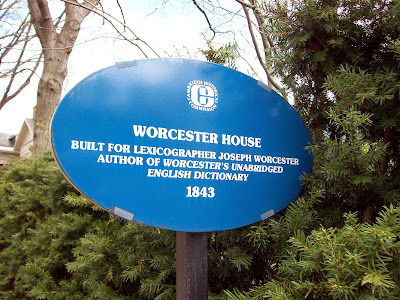.jpg)
The "Wash Tub" Square homes of art scholar Denman Waldo Ross at 25 Craigie Street and the Eben Horsford House at 27 Craigie Street are magnificent examples of Victorian architecture.
+-+26+Craigie.jpg)
.jpg)
The William Brewster House at 145 Brattle Street was the home of ornithologist William Brewster and was the original site of the Lechmere-Sewall-Riedesel House.


The Gardiner Hubbard House at 146 Brattle Street was owned by philanthropist Gardiner Greene Hubbard. Gardiner's daughter Mabel married famed inventor Alexander Graham Bell.

The Thomas Lee House at 153 Brattle Street was built in 1799 and is a fine example of Colonial architecture.
.jpg)
Charles Bahne also led the "Cambridge in 1775" walking tour in April. For information about this tour please visit my blog post Cambridge in 1775 Walking Tour. For additional information about classes and walks at the Cambridge Center for Adult Education please visit their website at https://www.ccae.org.
References:
1Cambridge Historical Society, "Cambridge and the American Revolution: William Brattle House,", Brattle House (http://cambridgehistory.org/discover/Cambridge-Revolution/Brattle%20House.html: 09 May 2014). Cambridge Historical Society, "Cambridge and the American Revolution: Powder Alarm,", French and Indian War (http://cambridgehistory.org/discover/Cambridge-Revolution/Powder%20Alarm.html: 09 May 2014).
2Cambridge Historical Society, "Henry Vassall House,", Vassall House (http://cambridgehistory.org/discover/Cambridge-Revolution/Vassall%20House.html: 09 May 2014).
3Cambridge Historical Society, "Vassall-Craigie-Longfellow House,", Vassall-Craigie-Longfellow House (http://www.cambridgehistory.org/discover/Cambridge-Revolution/Longfellow%20House.html: 09 May 2014). "Henry Wadsworth Longfeollow - His Homes,", The Homes of Henry Wadsworth Longfellow(http://www.hwlongfellow.org/house_overview.shtml: 09 May 2014).
4Cambridge Historical Society, "Lechmere-Sewall-Riedesel House,", Lechmere-Sewell-Riedesel House (http://cambridgehistory.org/discover/Cambridge-Revolution/Riedesell%20House.html: 09 May 2014).
5Cambridge Historical Society, "Hooper-Lee-Nichols House,", Hooper-Lee-Nichols House (http://www.cambridgehistory.org/discover/Cambridge-Revolution/Hooper%20Lee%20Nichols%20House.html: 09 May 2014).
6Cambridge Historical Society, "Ruggles-Fayerweather House,", Ruggles-Fayerweather House (http://www.cambridgehistory.org/discover/Cambridge-Revolution/Ruggles-Fayerweather%20House.html: 09 May 2014).
7Cambridge Historical Society, "Elmwood,", Elmwood (http://www.cambridgehistory.org/discover/Cambridge-Revolution/Elmwood.html: 09 May 2014).
The tour began at the William Brattle House at 42 Brattle Street, which is now the main facility of the Cambridge Center for Adult Education. General Major William Brattle Jr. was a decorated military hero of the French and Indian War. Although he appeared to sympathize with the patriots he was a Loyalist, siding with the British Crown in the tensions leading up to the American Revolution. In August of 1774 Brattle wrote a letter to Thomas Gage, the Royal Governor of Massachusetts, informing him of the formation of local militias and the storing of gunpowder in local arsenals. Three days later Gage ordered three hundred soldiers to sail up the Mystic River to Charlestown to seize the gunpowder. The "Powder Alarm" enraged the citizens of Cambridge, who formed a rally of four thousand attendees on the Cambridge Common the next day to protest Gage's actions and to demand the resignation of three Loyalist members of the Mandamus Council appointed by the British Crown. One of the members, Lieutenant Governor Thomas Oliver, rode to Boston to prevent Governor Gage from sending soldiers in an attempt to suppress the crowd. Oliver returned to Cambridge, assuring the crowd that Gage would not employ military action in order to persuade the crowd to disperse peacefully. However, a hated tax collector, Benjamin Hallowell, rode past the crowd in his carriage, and a group of enraged citizens pursued his carriage. After these episodes William Brattle, as well other Cambridge Loyalists, left their Cambridge homes for safer lodgings in Boston. The Loyalists remained in Boston during the Siege of Boston in 1775-1776 and departed from Boston with the British soldiers on Evacuation Day, March 17, 1776.1
.jpg)
The Henry Vassall House at 94 Brattle Street is named for its original owner, Henry Vassall, a wealthy Loyalist landowner and heir to his father's Jamaican plantation and trading interests. Henry Vassall died in 1769. His wife Penelope Royall Vassall vacated the home in 1775 with other Cambridge Loyalists. This home served as the medical headquarters of the Continental Army. Dr. Benjamin Church, a renowned Boston physician, was named by the Continental Congress as the Surgeon General of the Continental Army. Church was later revealed as a traitor to the Revolutionary cause and was held prisoner in this house until his exile from the American Colonies in 1778. 2


The Longfellow House-Washington Headquarters National Historical Site at 105 Brattle Street was built by John Vassall Jr., a Loyalist nephew of Henry Vassall. John Vassall Jr. married Elizabeth Oliver, the sister of Lieutenant Governor Thomas Oliver. The Vassall Family fled the house in 1774 after the "Powder Alarm" rally on Cambridge Common and the ensuing harsh treatment of Governor Oliver. General George Washington established his headquarters here during the Siege of Boston. Fireside poet Henry Wadsworth Longfellow lived in this house from 1843 until his death in 1862. At Longfellow's 1843 marriage to Fanny Appleton her father, Nathan Appleton, gave the newly-married couple this house as a wedding gift. Longfellow's descendants lived in this home until 1950.3:




The Lechmere-Sewall-Riedesel House at 149 Brattle Street was originally the home of Richard Lechmere, proprietor of Lechmere Point in East Cambridge. The home was later owned by Jonathan Sewell, a Loyalist and the last Attorney General under British rule in Massachusetts. The Sewall family left Cambridge with other Loyalists after the "Powder Alarm" rally on Cambridge Common in September 1774. After the capture of British General John Burgoyne at the Battle of Saratoga Baron Von Riedesel, the leader of the German mercenaries, known as Hessians, lived in this house with his wife as prisoners of war. 4

The Hooper-Lee-Nichols house at 159 Brattle Street was built by Dr. Richard Hooper in 1685 and is the second oldest home in Cambridge. The home was later owned by Joseph Lee, a Loyalist Mandamus councillor and a founder of Christ Church. Lee resigned from the Mandamus Council and fled his home in September 1774 after the "Powder Alarm" rally on Cambridge Common. Subsequently the home of George Nichols the house became the headquarters of the Cambridge Historical Society in 1957.5


The Ruggles-Fayerweather house at 175 Brattle Street was owned by George Ruggles, a Loyalist who fled Cambridge in the 1770s and sold the house to Thomas Fayerweather. During the Siege of Boston the house was confiscated by the Continental Army and utilized as a hospital. The Fayerweathers moved to another home during the Siege of Boston and reclaimed their home after the British evacuation.6


The Thomas Oliver house at 33 Elmwood Avenue was built by Loyalist Thomas Oliver, the last lieutenant governor of the Massachusetts Bay Colony and a brother-in-law to John Vassall Jr. Oliver quieted the crowd during the "Powder Alarm" rally on Cambridge Common in September of 1774, but later that day his home was surrounded by patriots, demanding his resignation. The house was subsequently the home of Vice President Elbridge Gerry and was later owned by Fireside poet James Russell Lowell (1819-1891), a lifelong resident of the home. The house's location on 33 Elmwood Avenue was once a portion of Brattle Street.7


We also visited other historic homes along and near Brattle Street that were built after the American Revolution.
The Oliver Hastings House at 101 Brattle Street, adjacent to Longfellow-Washington Headquarters, was the home of local builder Oliver Hastings.
.jpg)

The Joseph Worcester House at 121 Brattle Street was the home of lexicographer Joseph Worcester, author of Worcester's Unabridged English Dictionary.
.jpg)
.jpg)
The "Wash Tub" Square homes of art scholar Denman Waldo Ross at 25 Craigie Street and the Eben Horsford House at 27 Craigie Street are magnificent examples of Victorian architecture.
+-+26+Craigie.jpg)
.jpg)
The William Brewster House at 145 Brattle Street was the home of ornithologist William Brewster and was the original site of the Lechmere-Sewall-Riedesel House.


The Gardiner Hubbard House at 146 Brattle Street was owned by philanthropist Gardiner Greene Hubbard. Gardiner's daughter Mabel married famed inventor Alexander Graham Bell.

The Thomas Lee House at 153 Brattle Street was built in 1799 and is a fine example of Colonial architecture.
.jpg)
Charles Bahne also led the "Cambridge in 1775" walking tour in April. For information about this tour please visit my blog post Cambridge in 1775 Walking Tour. For additional information about classes and walks at the Cambridge Center for Adult Education please visit their website at https://www.ccae.org.
References:
1Cambridge Historical Society, "Cambridge and the American Revolution: William Brattle House,", Brattle House (http://cambridgehistory.org/discover/Cambridge-Revolution/Brattle%20House.html: 09 May 2014). Cambridge Historical Society, "Cambridge and the American Revolution: Powder Alarm,", French and Indian War (http://cambridgehistory.org/discover/Cambridge-Revolution/Powder%20Alarm.html: 09 May 2014).
2Cambridge Historical Society, "Henry Vassall House,", Vassall House (http://cambridgehistory.org/discover/Cambridge-Revolution/Vassall%20House.html: 09 May 2014).
3Cambridge Historical Society, "Vassall-Craigie-Longfellow House,", Vassall-Craigie-Longfellow House (http://www.cambridgehistory.org/discover/Cambridge-Revolution/Longfellow%20House.html: 09 May 2014). "Henry Wadsworth Longfeollow - His Homes,", The Homes of Henry Wadsworth Longfellow(http://www.hwlongfellow.org/house_overview.shtml: 09 May 2014).
4Cambridge Historical Society, "Lechmere-Sewall-Riedesel House,", Lechmere-Sewell-Riedesel House (http://cambridgehistory.org/discover/Cambridge-Revolution/Riedesell%20House.html: 09 May 2014).
5Cambridge Historical Society, "Hooper-Lee-Nichols House,", Hooper-Lee-Nichols House (http://www.cambridgehistory.org/discover/Cambridge-Revolution/Hooper%20Lee%20Nichols%20House.html: 09 May 2014).
6Cambridge Historical Society, "Ruggles-Fayerweather House,", Ruggles-Fayerweather House (http://www.cambridgehistory.org/discover/Cambridge-Revolution/Ruggles-Fayerweather%20House.html: 09 May 2014).
7Cambridge Historical Society, "Elmwood,", Elmwood (http://www.cambridgehistory.org/discover/Cambridge-Revolution/Elmwood.html: 09 May 2014).
Wednesday, May 7, 2014
Remembering the Battle of the Wilderness - 150 Years Later
This week marks the sesquicentennial anniversary of the Battle of the Wilderness, the inaugural battle of General Ulysses S. Grant's Overland Campaign of 1864. Union General Grant planned his strategy to draw Confederate General Robert E. Lee out of his entrenched position along the Rapidan River onto open ground. On May 5, 1864, both armies met at a heavily wooded area known as the Wilderness, several miles northwest of the Chancellorsville intersection. A two-day battle raged along farmlands and woods, resulting in heavy casualties to both armies.
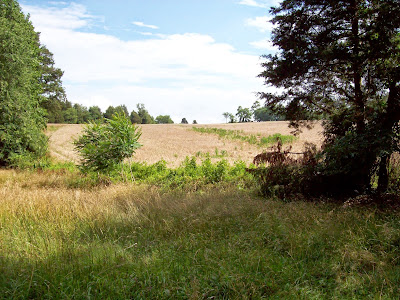.jpg)



The Union forces stubbornly and successfully defended the intersection of the Orange Plank and Brock Roads, as loss of this vital crossroads would have divided the Union Army.

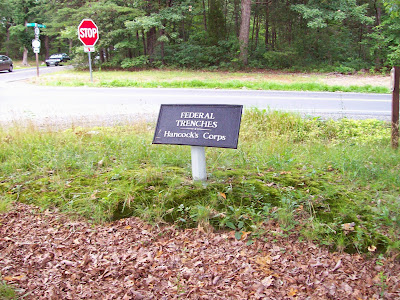.jpg)
The Battle of the Wilderness was considered a brutal stalemate, but General Grant, unlike his predecessors, advanced rather than retreated after the battle. As Grant moved south along the Brock Road toward Spotsylvania his troops saluted him with cheers.
My second great-granduncle Oliver Bates served with the 20th Massachusetts Infantry Regiment at the Wilderness and was stationed with General Winfield S. Hancock's Second Corps in trenches along the Brock Road. The 20th Massachusetts suffered heavy casualties at the Wilderness, and Oliver was very fortunate to have survived this hellish fray. On May 7 he advanced toward Spotsylvania with the 20th Massachusetts.1
For additional information about Oliver Bates and the 20th Massachusetts Infantry Regiment please visit http://20thmassregt150.blogspot.com.
References:
1Compiled service record, Oliver S. Bates, Pvt., Co. A, 20th Massachusetts Infantry; Carded Records, Volunteer Organizations, Civil War; Records of the Adjutant General's Office, 1780s-1917, Record Group 94; National Archives, Washington, D.C.
.jpg)



The Union forces stubbornly and successfully defended the intersection of the Orange Plank and Brock Roads, as loss of this vital crossroads would have divided the Union Army.

.jpg)
The Battle of the Wilderness was considered a brutal stalemate, but General Grant, unlike his predecessors, advanced rather than retreated after the battle. As Grant moved south along the Brock Road toward Spotsylvania his troops saluted him with cheers.
My second great-granduncle Oliver Bates served with the 20th Massachusetts Infantry Regiment at the Wilderness and was stationed with General Winfield S. Hancock's Second Corps in trenches along the Brock Road. The 20th Massachusetts suffered heavy casualties at the Wilderness, and Oliver was very fortunate to have survived this hellish fray. On May 7 he advanced toward Spotsylvania with the 20th Massachusetts.1
For additional information about Oliver Bates and the 20th Massachusetts Infantry Regiment please visit http://20thmassregt150.blogspot.com.
References:
1Compiled service record, Oliver S. Bates, Pvt., Co. A, 20th Massachusetts Infantry; Carded Records, Volunteer Organizations, Civil War; Records of the Adjutant General's Office, 1780s-1917, Record Group 94; National Archives, Washington, D.C.
Friday, May 2, 2014
St. Michael Cemetery Walking Tour
On Saturday I attended a brief walking tour of St. Michael Cemetery with a group of genealogy friends and colleagues from the Boston University Genealogy program. The tour of St. Michael Cemetery adjoined our tour of Forest Hills Cemetery, as the two cemeteries face each other across Walk Hill Street in the Forest Hills neighborhood of Boston.
St. Michael Cemetery was established in 1905 to serve the burial needs of the ever-growing Italian population of the Boston area. It was the deep wish of the Italian community to have a burial ground that preserved their cultural traditions.
We walked through the main gate of St. Michael and visited several of the beautiful memorial statues that adorn the cemetery. Each monument reveals the deep religious faith of the Italian community buried within its grounds.













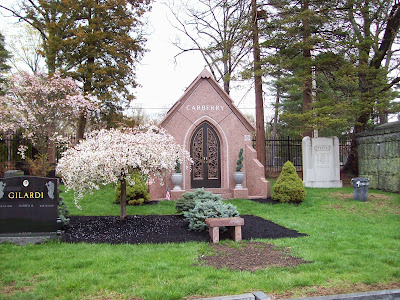
I have many memories of visiting this cemetery during my childhood and adulthood, as my own dear grandparents Vincenzo and Antonetta are buried in this cemetery.
For additional information about St. Michael Cemetery please visit their website at http://www.stmichaelcemetery.com.
St. Michael Cemetery was established in 1905 to serve the burial needs of the ever-growing Italian population of the Boston area. It was the deep wish of the Italian community to have a burial ground that preserved their cultural traditions.
We walked through the main gate of St. Michael and visited several of the beautiful memorial statues that adorn the cemetery. Each monument reveals the deep religious faith of the Italian community buried within its grounds.














I have many memories of visiting this cemetery during my childhood and adulthood, as my own dear grandparents Vincenzo and Antonetta are buried in this cemetery.
For additional information about St. Michael Cemetery please visit their website at http://www.stmichaelcemetery.com.
Subscribe to:
Posts (Atom)